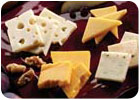
From whole to skim, creamed to whipped, fluid milk and related milk products have a normal pH of 6.6 to 6.9. But this neutrality stops here. In order to transform fluid milk into one of the many other dairy products in the marketplace, pH must be reduced. This is accomplished through either the addition of product-specific starter cultures or food-grade acidulants. (For a discussion of the role of acidulants in lowering pH, refer to page 58.)

Cultures 101
Milk is pasteurized in order to destroy microbial contaminants without substantially altering milk's characteristics. Many of the microbes destroyed are the same ones that are added back to make certain fermented dairy foods. The difference is that when added back, culture growth is able to be somewhat controlled. Indeed, once milk is "cleaned up," starter cultures or acidulants can be added to provide particular characteristics, including a lower pH. When the pH of milk drops to 4.6, casein starts to precipitate, causing the liquid to thicken. Depending on the product, the target pH is generally 4.1 to 4.6.Starter cultures are acid-producing microorganisms that are used in the production of dairy products such as buttermilk, cheese, sour cream and yogurt. Although they are genetically diverse, common characteristics of these bacteria include being Gram-positive, non-motile and non-sporeforming. Producing acid from lactose is their primary function; however, starter cultures can contribute to flavor, aroma and gas production; proteolytic and lipolytic activities; and inhibition of undesirable organisms.
There are currently 12 genera of lactic acid bacteria, of which four contain organisms used in dairy fermentations: Lactococcus, Leuconostoc, Streptococcus and Lactobacillus (see accompanying chart). Important phenotypic taxonomic criteria to discriminate between the genera and species include morphological appearance (coccus or rod), temperature dependence (mesophilic or thermophilic), fermentation end products (heterofermentative or homofermentative), citrate metabolism, diacetyl production, and others.
Lactococcus is the most basic of all genus. They are composed of spherical cells (coccus) that form pairs or chains and are homofermentative, which means they produce only one product from lactose: lactic acid. L. lactis ssp. lactis biovar diacetylactis is also able to metabolize citrate, an organic acid naturally present in milk, which leads to the production of diacetyl and carbon dioxide. Diacetyl is an important flavoring compound in some dairy products.
The Leuconostoc generally used in dairy foods fermentations are heterofermentative coccus. They, too, metabolize citrate to diacetyl and carbon dioxide. Typically Leuconostoc are combined with a Lactococcus because Leuconostoc grows poorly in milk, and needs assistance to drop the pH to less than 5.1.
Only one Streptococcus species is used to ferment milk: Streptococcus thermophilus. Unlike Lactococcus and Leuconostoc, which are mesophilic, meaning they grow best at temperatures in the range of 20º to 40ºC, S. thermophilus is thermophilic. Thermophiles, as they are called, can and live and grow at temperatures that exceed 50ºC. They grow best at 35° to 41°C, and will grow in 2.5% salt.
The final genus, Lactobacillus, is a rod that grows optimally at 43° to 45°C. They are also homofermentative.
Straining for the right pH
After genus and species, starter cultures are further differentiated by strain. This is where suppliers tout their products. One supplier may have a faster-growing strain of a specific starter species. Another supplier many claim a more controllable strain.As mentioned, the primary function of starter cultures is the production of acid, particularly lactic acid. The rate of acid production naturally varies greatly with growth conditions such as temperature, pretreatment of the milk (especially heat treatment), presence of oxygen, etc. Working closely with a supplier is critical to ensure cost-effective starter culture growth. When checking the growth or acidification capacity of various starters in lab tests, one should ensure that these growth conditions simulate the conditions during manufacturing.
On the basis of their composition, starter cultures can be classified into one of three groups. First, single-strain cultures are just that: pure cultures of one strain. Multiple-strain cultures consist of a defined mixture of pure cultures of a few strains of different species of bacteria or of different strains of one species. Lastly, mixed-strained cultures consist of an undefined mixture of strains of different species of bacteria.
An area of concern for all dairy processors working with starter cultures, particularly cheesemakers, is bacteriophage. Bacteriophages are viruses that require bacteria host cells for growth and reproduction. Initially, the bacteriophage attaches itself to the bacteria cell wall and injects nuclear substance into the cell. Inside the cell, the nuclear substance produces shells, or phage coats, for the new bacteriophage, which are quickly filled with nucleic acid. The bacterial cell ruptures and dies as the new bacteriophage are released. Basically, bacteriophages attack and destroy most of the lactic acid bacteria added to milk during manufacturing, which prevents normal ripening. This is called a slow or dead vat.
Bacteriophages are everywhere, but generally enter the milk processing plant with the farm milk. They can be inactivated by heat treatment or by the use of chemical disinfectants. Suppliers offer specially selected strains that are described as bacteriophage resistant.
Keep in mind that starter culture greatly affects the properties of the final product. When choosing a starter focus on selecting bacterial strains with desirable properties; composing starters by applying suitable strains in appropriate proportions; and maintaining starter composition. Choosing the right starter is likely the most challenging part of product development.